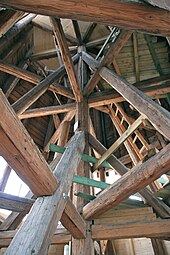Wennigsen Monastery
Wennigsen Monastery is a Protestant women's monastery in Wennigsen am Deister about 15 kilometers southwest of Hanover . It is one of the five Calenberg monasteries and is administered by the Hanover Monastery Chamber.
history
Wennigsen Monastery was probably founded around 1200. The Romanesque defense tower of today's monastery church is dated around 1150. It is assumed that Count Bernhard von Poppenburg , who called himself von Poppenburg and Spiegelburg at the time , made his property in Wennigsen available to the church for the foundation of a monastery. Konrad I. von Rüdenberg , Bishop of Minden from 1209 to 1236, probably established an Augustinian nunnery with these means - just like in Barsinghausen . The Wennigsen monastery was first mentioned in a document from 1224. Count Adolf III. In it, at the request of Bishop Konrad I von Rüdenberg, renounces his preferential rights to the church property of the Wennigsen monastery in favor of the bishop. The Schaumburg counts were Gografen wealthy of the local district and for over 100 years Deister foothills. This circumstance brought it with it that Count Adolf III. von Schauenburg and Holstein had preferential rights.
Later on, numerous foundations from other noble property were added to these Poppenburg property, including Schaumburg property; the count of schauenburg was the bailiwick subject to the monastery. The Counts of Poppenburg - later Spiegelberg - sat far away and had no authority in Wennigsen. They were therefore hardly considered as monastery bailiffs.
From 1261 to 1284 the monastery was also a place of pilgrimage .
The monastery developed very well thanks to the generous donations from the noble families of the Calenberg region . In the 13th century, the monastery was largely donated land, farms and tithes from the surrounding places - for example, all the possessions of the noble lords of Sorsum from the Lords of Goltern and the Guelphs - but the monastery did not become a separate monastery place in 1331 either For example Barsinghausen, when the Counts von Spiegelberg gave the monastery the place Spoltholtensen , today Holtensen , a district of Wennigsen.
The monastery church was expanded in the 13th and 14th centuries to include a nuns' choir in the northern transverse arm and a yoke in the nave . In the 15th century a yoke with a polygonal finish was added again.
In 1455 the monastery was reformed by Johannes Busch , he strived for a life in the "following of Christ" in order to counter the secularization.
Around 1520 the church was enlarged by a south aisle.
After 1542, the Reformation was introduced in the monastery by Duchess Elisabeth von Calenberg-Göttingen , but the monastery remained a noble fräuleinstift and came under the administration of the princely chancellery . During the Thirty Years' War the place was almost completely destroyed by fire, and the population suffered robbery and looting. In 1626 the monastery was looted. After the severe damage to the buildings during the Thirty Years War, the monastery was partially rebuilt in the 18th century. The current monastery buildings from the Baroque period were built between 1707 and 1725. The figure of the Virgin Mary from the founding time of the monastery, the goal of the former pilgrimage site, which disappeared during the Reformation, was walled in by the nuns and was rediscovered in 1908 during work on installing a heating system. Today she is placed in the church with other statues that were found on the same occasion. In 1920 the monastery served as an arsenal for the Reichswehr. After the Second World War , the monastery served as a refuge for more than a hundred refugees.
Wennigsen Monastery has remained a Protestant women's convent to this day, and "The House for Silence and Encounter" has been located here since 2002 - Via Cordis. The Order of St. John has moved into a part of the monastery as a tenant.
The central celebrations for the 450th anniversary of the death of the Guelph Duchess Elisabeth von Calenberg took place in spring 2008 in Wennigs monastery. Numerous representatives of the public life of Lower Saxony were present, the ZDF broadcast a service nationwide.
Redevelopment
In 2011 and 2012 the tower of the monastery church was extensively renovated for around half a million euros. This has a masonry made of sandstone in the lower part. In the upper part, the tower consists only of loose stones, which are held together by mortar. Filling material made of rubble was filled in between the outer and inner walls. Some of the interior was also built with clinker bricks. Partial renovation had already been carried out in the 1950s.
During the last renovation in 2010/2012, the entire facade of the Romanesque defense tower was re-grouted with mortar from the region. Properties and color could thus be retained as true to the original as possible. Stones in the masonry were also replaced and large parts of the roof structure and its shingles were replaced. On the top level of the tower's end stones, a new base was built and the statics of the roof structure corrected. The old roof truss stood with its entire weight on the outer stones, so that it pushed the masonry outwards. All five bells were also repaired.
See also
literature
- 750 years of Wennigsen, Deister 1200–1950 . Wennigsen 1950.
- Antje Busch-Sperveslage: The monastery church in Wennigsen . Steinbacher, Osnabrück 1999, ISBN 3-9805661-8-8 .
Web links
- Wennigsen Monastery website
- Description of Wennigsen Monastery on the Lower Saxony monastery map of the Institute for Historical Research
Individual evidence
- ↑ 750 years of Wennigsen 1200 - 1950 , published by the preparatory committee for the 750th anniversary of the Wennigsen community, printed in 1950 by the Hannover Book Printing Workshop, p. 8
- ^ The black Madonna von Wennigsen , article from April 4, 2012 on the NDR website
Coordinates: 52 ° 16 ′ 27.8 " N , 9 ° 34 ′ 27" E








